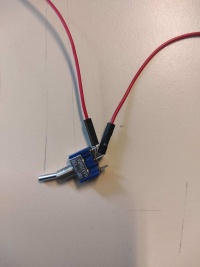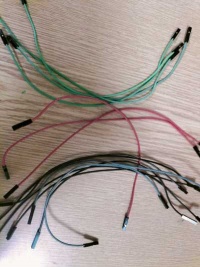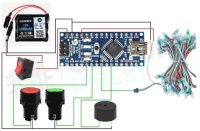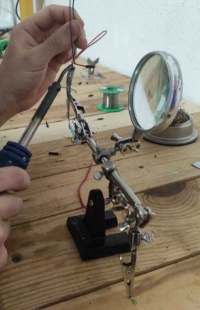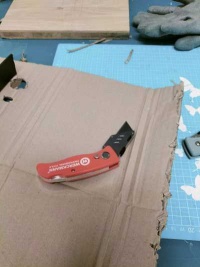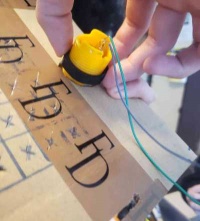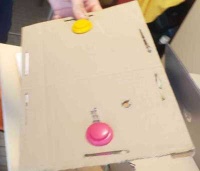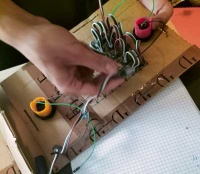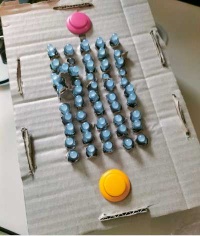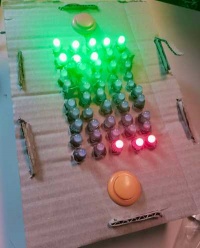ENIB 2024 : Smash The Button
Titre de la fiche expérience :
Sommaire
Description
Notre équipe est composée de 4 membres : Samuel, Mathieu, Loane et Maïa.
Mettre image avec projet fini
Introduction
éventuelle vidéo
Le nom de notre jeu est Smash The Button. Il s’agit d’un jeu en un contre un. Le but est de conquérir un maximum de territoire en un minimum de temps. Le vainqueur est celui ayant le plus grand territoire.
Outil et matériel
Nous avons utilisé comme matériel un WS2811 LED Strip (permettant d’obtenir un grand nombre de LED), deux boutons poussoirs l’un rouge l’autre jaune, une carte Arduino Nano, un buzzer, une batterie externe et un bouton pour lancer le jeu.
Fichiers à joindre
code, ficher d'impression 3D, de découpe laser ou vinyle, ...
Code Arduino
1
2 #include <FastLED.h>
3
4 #define LED_PIN 5
5
6 #define BUZZER_PIN 7
7
8 #define NUM_LEDS 50
9
10 #define BUTTON_PIN1 2
11
12 #define BUTTON_PIN2 3
13
14 #define DELAY_MS 50
15
16 #define RED_BUTTON_FREQ 100 // Frequency for the red button sound
17
18 #define GREEN_BUTTON_FREQ 200 // Frequency for the green button sound
19
20 CRGB leds[NUM_LEDS];
21
22 int ledCount1 = 0; // Number of red LEDs to light up from one end
23
24 int ledCount2 = 0; // Number of green LEDs to light up from the other end
25
26 bool buttonState1 = false;
27
28 bool lastButtonState1 = false;
29
30 bool buttonState2 = false;
31
32 bool lastButtonState2 = false;
33
34 bool isRedButtonPressed = false;
35
36 bool isGreenButtonPressed = false;
37
38 void setup() {
39
40 FastLED.addLeds<WS2812B, LED_PIN, GRB>(leds, NUM_LEDS);
41
42 pinMode(BUTTON_PIN1, INPUT_PULLUP);
43
44 pinMode(BUTTON_PIN2, INPUT_PULLUP);
45
46 pinMode(BUZZER_PIN, OUTPUT);
47
48 }
49
50 void loop() {
51
52 buttonState1 = digitalRead(BUTTON_PIN1) == LOW;
53
54 buttonState2 = digitalRead(BUTTON_PIN2) == LOW;
55
56 if (buttonState1 != lastButtonState1) {
57
58 if (buttonState1) {
59
60 // Button 1 is pressed
61
62 ledCount1++;
63
64 if (ledCount1 > NUM_LEDS) {
65
66 ledCount1 = NUM_LEDS;
67
68 }
69
70 isRedButtonPressed = true;
71
72 tone(BUZZER_PIN, RED_BUTTON_FREQ); // Play the red button sound
73
74 }
75
76 lastButtonState1 = buttonState1;
77
78 }
79
80 if (buttonState2 != lastButtonState2) {
81
82 if (buttonState2) {
83
84 // Button 2 is pressed
85
86 ledCount2++;
87
88 if (ledCount2 > NUM_LEDS) {
89
90 ledCount2 = NUM_LEDS;
91
92 }
93
94 isGreenButtonPressed = true;
95
96 tone(BUZZER_PIN, GREEN_BUTTON_FREQ); // Play the green button sound
97
98 }
99
100 lastButtonState2 = buttonState2;
101
102 }
103
104
105
106 // Turn off all LEDs
107
108 FastLED.clear();
109
110
111
112 // Light up the specified number of red LEDs from one end
113
114 for (int i = 0; i < ledCount1; i++) {
115
116 leds[i] = CRGB::Green;
117
118 }
119
120
121
122 // Light up the specified number of green LEDs from the other end
123
124 for (int i = NUM_LEDS - 1; i >= NUM_LEDS - ledCount2; i--) {
125
126 leds[i] = CRGB::Red;
127
128 }
129
130
131
132 if ((ledCount1 + ledCount2) >= NUM_LEDS) {
133
134 if (ledCount1 > ledCount2) {
135
136 greenChaserEffect();
137
138 } else if (ledCount2 > ledCount1) {
139
140 redChaserEffect();
141
142 } else {
143
144 // It's a tie
145
146 tieChaserEffect();
147
148 }
149
150
151
152 // Reset the LED counts
153
154 ledCount1 = 0;
155
156 ledCount2 = 0;
157
158 }
159
160
161
162 // Show the updated LED strip
163
164 FastLED.show();
165
166
167
168 if (isRedButtonPressed || isGreenButtonPressed) {
169
170 delay(50); // Adjust this delay to control the duration of the buzzer sound
171
172 noTone(BUZZER_PIN); // Stop the buzzer sound
173
174 isRedButtonPressed = false;
175
176 isGreenButtonPressed = false;
177
178 }
179
180
181
182 delay(50); // Adjust this delay to debounce the buttons and control the response speed
183
184 }
185
186
187
188 void tieChaserEffect() {
189
190
191
192 for (int i = 0; i < NUM_LEDS / 2; i++) {
193
194 leds[i] = CRGB::Red; // Set the color of the current LED to red
195
196 FastLED.show(); // Update the LED strip
197
198 delay(DELAY_MS); // Wait for a short period
199
200 }
201
202
203
204 for (int i = NUM_LEDS; i >= NUM_LEDS / 2; i--) {
205
206 leds[i] = CRGB::Green; // Set the color of the current LED to red
207
208 FastLED.show(); // Update the LED strip
209
210 delay(DELAY_MS); // Wait for a short period
211
212 }
213
214 }
215
216
217
218 void greenChaserEffect() {
219
220 // Set all LEDs to green initially
221
222 for (int i = 0; i < ledCount1; i++) {
223
224 leds[i] = CRGB::Green;
225
226 }
227
228 FastLED.show(); // Update the LED strip with the initial green color
229
230
231
232 for (int i = ledCount1; i < NUM_LEDS; i++) {
233
234 leds[i] = CRGB::Green; // Set the color of the current LED to red
235
236 FastLED.show(); // Update the LED strip
237
238 delay(DELAY_MS); // Wait for a short period
239
240 }
241
242 }
243
244
245
246 void redChaserEffect() {
247
248 // Set all LEDs to green initially
249
250 for (int i = NUM_LEDS - 1; i >= NUM_LEDS - ledCount2; i--) {
251
252 leds[i] = CRGB::Red;
253
254 }
255
256 FastLED.show(); // Update the LED strip with the initial green color
257
258
259
260 for (int i = ledCount2; i > 0; i--) {
261
262 leds[i] = CRGB::Red; // Set the color of the current LED to red
263
264 FastLED.show(); // Update the LED strip
265
266 delay(DELAY_MS); // Wait for a short period
267
268 }
269
270 }
Étapes de fabrication
indiquer autant d'étape que nécessaire, chacune illustrée par des images (phot, dessins, ...)
Étape 1
Tout d'abord nous avons fait l'inventaire de ce dont nous avions besoin. Il nous manquait une alimentation, trois câbles rouges, sept câbles noir ou gris et quatre câbles de couleur (vert).
Étape 2
Mise en place de carte (communication)
Étape 3
Puis nous avons fait le câblage à l'aide de ce schéma.
Étape 4
Puis nous avons souder notre câblage afin d'obtenir un rendu propre.
Étape 5
Nous avons choisit le matériau pour faire la patron, nous avons choisit le carton. On a alors dessiné le patron.
Étape 6
Ensuite, nous sommes passés au découpage.
Étape 7
Après, nous sommes passés à l'assemblage. Tout d'abord nous nous sommes occupés des boutons.
On obtient ceci.
Mise en place des différentes LED sur le support.
Étape 8
On obtient après assemblage, une version éteinte et une version allumée.
Problèmes rencontrés
Nous avons eux un problème de compilation avec la carte Arduino Nano.

